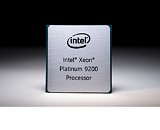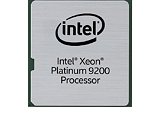Tuesday, August 6th 2019

Next-generation Intel Xeon Scalable Processors to Deliver Breakthrough Platform Performance with up to 56 Processor Cores
Intel today announced its future Intel Xeon Scalable processor family (codename Cooper Lake) will offer customers up to 56 processor cores per socket and built-in AI training acceleration in a standard, socketed CPU as part of its mainline Intel Xeon Scalable platforms, with availability in the first half of 2020. The breakthrough platform performance delivered within the high-core-count Cooper Lake processors will leverage the capabilities built into the Intel Xeon Platinum 9200 series, which today is gaining momentum among the world's most demanding HPC customers, including HLRN, Advania, 4Paradigm, and others.
"The Intel Xeon Platinum 9200 series that we introduced as part of our 2nd Generation Intel Xeon Scalable processor family generated a lot of excitement among our customers who are deploying the technology to run their high-performance computing (HPC), advanced analytics, artificial intelligence and high-density infrastructure. Extended 56-core processor offerings into our mainline Intel Xeon Scalable platforms enables us to serve a much broader range of customers who hunger for more processor performance and memory bandwidth."
-Lisa Spelman, vice president and general manager of Data Center Marketing, Intel CorporationThe future Intel Xeon Scalable processors (codename Cooper Lake) will deliver twice the processor core count (up to 56 cores), higher memory bandwidth, and higher AI inference and training performance compared to the standard Intel Xeon Platinum 8200 processor. The future 56-core Cooper Lake processor is expected to deliver a lower power envelope than the current Intel Xeon Platinum 9200 processors. Cooper Lake will be the first x86 processor to deliver built-in high-performance AI training acceleration capabilities through new bfloat16 support added to Intel Deep Learning Boost (Intel DL Boost ). Cooper Lake will have platform compatibility with the upcoming 10nm Ice Lake processor.
For more than 20 years, Intel Xeon processors have delivered the platform and performance leadership that gives data center and enterprise customers the flexibility to pick the right solution for their computing needs. Next-generation Intel Xeon Scalable processors (Cooper Lake) build off Intel's uninterrupted server processor track record by delivering leadership performance for customers' real-world workloads and business application needs.
Intel Xeon Platinum 9200 processors are available for purchase today as part of a pre-configured systems from select OEMs, including Atos, HPE, Lenovo, Penguin Computing, Megware and authorized Intel resellers. Learn more information about the Intel Xeon Platinum 9200 processors.
"The Intel Xeon Platinum 9200 series that we introduced as part of our 2nd Generation Intel Xeon Scalable processor family generated a lot of excitement among our customers who are deploying the technology to run their high-performance computing (HPC), advanced analytics, artificial intelligence and high-density infrastructure. Extended 56-core processor offerings into our mainline Intel Xeon Scalable platforms enables us to serve a much broader range of customers who hunger for more processor performance and memory bandwidth."
-Lisa Spelman, vice president and general manager of Data Center Marketing, Intel CorporationThe future Intel Xeon Scalable processors (codename Cooper Lake) will deliver twice the processor core count (up to 56 cores), higher memory bandwidth, and higher AI inference and training performance compared to the standard Intel Xeon Platinum 8200 processor. The future 56-core Cooper Lake processor is expected to deliver a lower power envelope than the current Intel Xeon Platinum 9200 processors. Cooper Lake will be the first x86 processor to deliver built-in high-performance AI training acceleration capabilities through new bfloat16 support added to Intel Deep Learning Boost (Intel DL Boost ). Cooper Lake will have platform compatibility with the upcoming 10nm Ice Lake processor.
For more than 20 years, Intel Xeon processors have delivered the platform and performance leadership that gives data center and enterprise customers the flexibility to pick the right solution for their computing needs. Next-generation Intel Xeon Scalable processors (Cooper Lake) build off Intel's uninterrupted server processor track record by delivering leadership performance for customers' real-world workloads and business application needs.
Intel Xeon Platinum 9200 processors are available for purchase today as part of a pre-configured systems from select OEMs, including Atos, HPE, Lenovo, Penguin Computing, Megware and authorized Intel resellers. Learn more information about the Intel Xeon Platinum 9200 processors.


56 Comments on Next-generation Intel Xeon Scalable Processors to Deliver Breakthrough Platform Performance with up to 56 Processor Cores
64 cores 225W vs 56 cores 400W , this is a no-brainer .
So sad to see this, they can only keep spamming the HW sites with more and more "New HW" slides.
Assuming the leak is correct, it does in some tests. Dual socket setup being 2x28 cores vs 64.
There are going to be no mainstream servers with these, just a handful of HPC only boxes that will have to be watercooled...
Penguin computing doesn't even list these (one of the hpc vendors in the list) Cray said they were going to make a box but have not shown it yet, that is why HPE is in the list, they recently acquired Cray, but there will be no HPE Proliants with them in them, only select Apollo servers for Megascale customers for Supercomputers.
This is Damage control before Epyc launch.
www.servethehome.com/amd-epyc-rome-namd-intel-xeon-computex-2019/
www.servethehome.com/intel-xeon-platinum-9200-series-lacks-mainstream-support/
www.servethehome.com/2020-cooper-lake-socketed-with-56-cores-and-bfloat16/
www.servethehome.com/amd-epyc-rome-namd-intel-xeon-computex-2019/
On the other side of the fence, Rome is kind of out there (in supercomputers for practically a year) but still not officially released.
As for those CPUs, probably the AI part could be interenting and something where Intel could differenciate itself from AMD. As for the cores, at 14nm,.... well, HUGE PSU...
This is about cooperlake because the industry Balked at the paper launch of 9200 bga chips, these are socketed...and "less power" but not 10nm, but will be upgradeable to 10nm icelake.... in a few years.
This is very much a please don't buy epyc, we promise we are not done competing, and I am certain they are not done, but they are certainly in one of the worst positions they have ever been in on the server market.
What they do have is a clock speed advantage because of 14nm, so they will retain competitiveness in certain workloads, however they cannot flex that too strongly or they will have performance degradations with icelake 10nm. as we have seen their 10nm+ having 600-1000mhz clock reductions on the icelake laptop chips erasing the 18% ipc gains.
We are surprised a $7800 chip beating 2x $10000 chip
And a 225W chip beating 2x 205W chip.